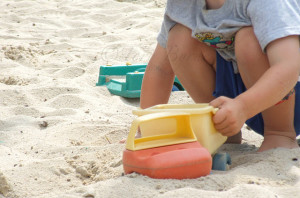by Kimberly Allen, DC, DACCP – ICPA.org:
Having fun with your child is important, but good play routines can last a lifetime.
It is a parent’s responsibility to stimulate their child’s developing nervous system with every motion and activity. These motions are helpful in developing neurological pathways. Parents also need to remember that although “educational” video games have been developed for babies up to young adults, they do not stimulate the same neural pathways in the brain as active play activities. Play activities should include stimulation of all five senses (sight, touch, sound, smell, and taste). The following are some different play activities you can use to incorporate neurological development techniques into your child’s daily routine.
• Visual (sight): Tossing beanbags, blowing bubbles, taking photos with a camera, dancing with scarves or movement with different colored scarves for the infant, using both hands to draw shapes and letters or to hold objects, and tracing letters or numbers on a person’s back and having them traced upon own back.
• Tactile (touch): Different textures (smooth, rough, uneven), splashing water in a bathtub, building blocks, examining natural objects such as feathers and pinecones, petting and feeding animals, eating snacks with different textures, hugging, and manipulating small objects such as Legos, puzzles, and lacing beads.
• Auditory (sound): Dancing or moving to music, humming, musical chairs, beating rhythm on instruments, singing sounds where words need to be added (“Old McDonald had a …” Or “B-I-N-G-O”), and jumping rope while chanting or singing.
• Smells and Tastes: Introduce the child to different smells and tastes and look for appropriate reaction. For example, a sour face in response to a sour taste. Have the child name different smells such as coffee, fruits, and perfumes.
• Vestibular (equilibrium/balance): Spinning in circles, balancing on a teeter-totter, jumping on a bed, climbing on jungle gyms, sliding down a slide, walking on uneven surfaces (sand, grass), crawling through small spaces, allowing child to reach with right hand across the body to any object on the left and vice versa, and also tummy time for infants.
• Proprioceptive (sense stimuli): Pushing and pulling toys or wagon; tumbling to the ground; pillow fights; playing catch with a ball; kneading dough; getting in or out of seatbelts, jackets, boots, shoes, and socks; playing horsy; stretching up to the sky; obstacle courses; and pouring water or sand from one container to the next.
These activities are excellent sources of play techniques that will stimulate the development of your child’s neural pathways. Please remember that even though play is important, safety is more important. Some activities may cause injuries similar to that of Shaken Baby Syndrome.
Shaken Baby Syndrome was originally referred to as a “whiplash” injury. Shaken Baby Syndrome occurs when a child is shaken violently in a to-andfro fashion. Such violence can cause hematomas (bruising) in the area between the skull and the brain, retinal hemorrhaging (bleeding in the eyes), and, less commonly, fractures to the skull.
Though most people feel that Shaken Baby Syndrome occurs only as an act of violence, it can also occur during play activities that were never meant to harm. These activities include:
• Repeated and vigorous tossing of a child into the air. This allows a “whipping” motion of the head and neck.
• Jogging with infant on back or shoulders. Just because the infant is in a carrying restraint does not mean that head is supported in a neutral position.
• Bouncing the child on knee or swaying the leg back and forth, creating a to-and-fro motion and a “whipping” motion of the head and neck.
• Swinging child around by ankles. The child will attempt to move head against force of motion. This can cause “whipping” of the head and neck.
• Spinning child around in circles. The child’s head will feel very heavy and will often fall backwards, causing the “whipping” motion.
Signs and/or symptoms of brain stem swelling (e.g. Shaken Baby Syndrome) include: constant crying, stiffness, inability to wake up or sleeping more than usual, and vomiting. If you see any of these symptoms in your infant or child after any play or injury, take them to their doctor immediately. Please use caution at all times in order to best protect your infant or child from such injuries.
Just remember, having fun is important, but good play routines can last a lifetime.
